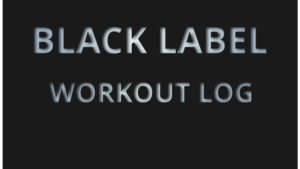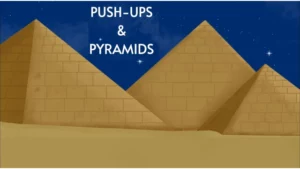
Increase Your Odds of Success
So if you’ve read this blog, you know my stance on already having the tools needed to succeed. You research on the exercises to implement into your training routine. Check! You have your schedule as to when you will workout. Check! You’re ready to go, right? Not quite so fast! You need to set some goals! Let’s take a brief moment to discuss why this is a very important tool that will dramatically increase your odds of achieving success.
You probably have heard about the infamous study in 1979 where a group of researchers supposedly interviewed the graduating class from the esteemed Harvard Business School. The study was simple; the graduates were asked if they had written goals and a plan on how to achieve. The results of the study follow:
- 84% had no goals set at all.
- 13% had written goals, but no real concrete plan for how they would achieve them.
- 3% had both written goals and a plan for attaining them.
According to the story, the graduates were then followed up on 10 years after graduation to see how they were performing. The results follow.
- The 13% of the class with written goals were making twice as much as the 84% with no goals and plans at all
- The 3% of the class with both written goals and a plan were making 10x as much as the other 97% of the class
Now, many question whether or not the story is accurate. I’ve never seen any evidence that such a study actually took place, but that is beside the point. Really though, if you just use your common sense, whether the story is true or pure fiction, you can easily see how it would play out.
To use a seafaring analogy, if you don’t have a destination how can you ever expect to arrive? So those without a destination end up wherever chance takes them. If you have a destination, at least you have a target to aim for. Without a plan, when or if ever you arrive at your destination would be largely left to chance as well. Could you get lucky, perhaps catch the trade winds and end up at your destination? Sure. But it’s also a distinct possibility that you won’t end up at the target.
Now if you have a destination and a plan/route to get there, this would give you the best chance of actually arriving at your destination and with a plan on how to get there, would certainly aid in getting to the destination as fast as possible, right?
Importance of Preparation
Abraham Lincoln was quoted as saying “Give me six hours to chop down a tree and I will spend the first four sharpening the ax.” What does this mean? Many may think this is wasteful and silly. You might jump to the conclusion that the tree might have been done sooner if he would have just started the process of chopping the tree down. But the truth of the matter is, without spending the time up front to “sharpen” your axe, a lot more time could be wasted
But the brilliance behind this quote is that a competent and strong lumber jack, with a dull axe may never get the tree cut down. And he’s certainly going to waste a lot more effort and expend a lot more energy with every swing of the axe.
All of this is great, but how does it apply to setting goals? Read on for
SMART Goals
SMART is an acronym for the following:
- Specific
- Measurable
- Achievable
- Relevant
- Time-Bound
Specific
This is where you define your target. How specific is specific enough? This one is always “more is better!” The more specific you can be, the deeper the level of engagement you’ll end up having and the more likely to get exactly what you are looking for. For example, “I want to do pushups” is vague. Because its “pushups” (plural) and not “pushup” I know I need at least two to reach my goal. But how many do I actually want to do? In what time frame do I want to achieve this? Like Lincoln’s famous quote, the more time you put into this step, the more effective and efficient you will become at setting and achieving goals.
Measurable
This one is pretty self-explanatory. Back to the target analogy above, this is where a meaningful measure of success is incorporated into your goal. This is usually addressed by some quantity that can be used to gauge success. Want to increase the size of your savings account? How much money do you want? When do you want to have it by?
Achievable
For a goal to be achievable, you want to think about any external factors that are outside of your control that could impact it’s attainment. Do you have the time and resources needed to accomplish the goal? Are there any factors that are out of your control? For example, if you had a goal to go to the gym 4 days a week, say Monday, Tuesday, Thursday and Friday then you are dependent on a gym being open to meet the goal. With COVID-19, this presented and external factor that is out of your control and thus ultimately impacts attainment.
Another example would be time. If you work 10 hours a day, sleep for 8, then you have roughly 6 hours of time left in a given day for other activities, which would have to include time for refueling, errands, etc. Say you painted or were an aspiring musician and you set a goal for doing some associated activity for 8 hours a day. The goal would not be achievable based on your current time constraints. You would have to either reduce the number of hours dedicated to this goal or shave time from work or sleep in order to be achievable.
Relevant
Here’s where you do your due diligence to make sure the goal is aligned with other relevant goals. Is the goal worthwhile in your mind? Is the timing right? Is the goal going to take away from higher priority goals? You may want to learn to play the piano. But you also are looking to get certified in some area to improve job security and pay. Do you have enough time to take on another “project” at this point? What you want to do here is avoid stretching yourself too thin. We are all limited to 24 hours a day, so wise to make sure you put the most time and energy to higher priority goals.
This doesn’t mean you can’t still pursue lower priority items. You might decide you can devote to spend a couple hours a week on a lower priority goal, say playing the piano, because of the helpful mental benefits that would support other areas of your life. It’s only when the goal is disjointed with other higher priority items that you should consider excluding it until a more appropriate time is in order; like completing higher priority items first before taking on this new goal.
Time Bound
This is where you specify when you want to have your objective completed. For example, “I want to But what if I can’t hit my goal in the time frame I set? And to you, my answer would be, “So what?” Are you still making progress? Was it just that you didn’t reach your target by the date you initially wanted? Simply push out the deadline. It is still better to have a solid target to aim for than just aiming blindly at nothing. As Brian Tracy so eloquently put it, “There is no such thing as an unrealistic goal…only unrealistic deadlines.” Move it out to a more realistic time frame for completion!
For example, “I want to do pushups” is vague. Because its “pushups” (plural) and not “pushup” I know I need at least two to reach my goal. But how many do I actually want to do? In what time frame do I want to achieve this? Like Lincoln’s famous quote, the more time you put into this step, the more effective and efficient you will become at setting and achieving goals.
Setting Unstoppable Goals
Don’t skimp on this part. I want you to take some time to really think deeply about your goals before embarking on the journey. While I know it can be hard to rein in emotions, especially when you are chomping at the bit, resist the urge. Taking the time to plan can really can be the difference between achieving maximum success or failing to reach the fullest potential on your journey.
Happy SMART goal setting! For more information on SMART criteria, check out the SAMSHA’s fact sheet for setting SMART goals


